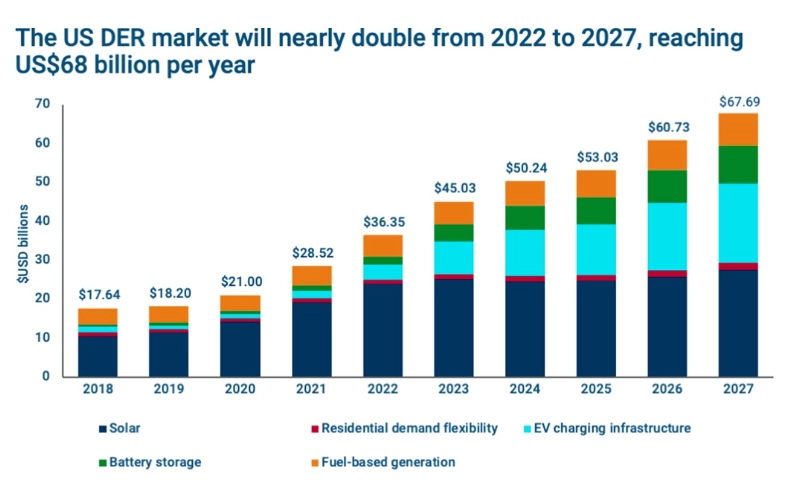
The EV charger market in the US is growing rapidly. The EV charger is expected to nearly double by 2027, according to Wood Mackenzie’s latest U.S. Distributed Energy Resource Outlook. The report projected 262 gigawatts (GW) of new distributed energy resources (DER) and demand for flexible capacity. This boom is mainly due to the growing demand for charger EV systems across the US. As EV adoption increases, so does the need for EV home charger setups and EV charger installation services.
DER Investments Rival Utility-Scale Energy
From 2023 to 2027, 262 GW of new Distributed Energy Resource (DER) and demand flexibility capacity will be installed. That number nearly matches the 272 GW of utility-scale resource additions forecasted in the same period. These DERs include EV chargers, battery storage, solar panels, and flexible demand systems.
This shift shows that local, customer-sited energy solutions are no longer just supplements. They are becoming the backbone of a decentralized energy future.
According to Wood Mackenzie, Distributed Energy Resources are the ones that fulfill the following requirements:
- The location of the resource should be on the customer’s premises.
- A resource must control the customer’s household electricity load.
- The primary purpose of DERs should be energy management. However, flexibility in customer energy demand is not the part of DERs.
- Non-CHP generators have a voltage restriction of 69 kV, which includes all EV chargers connected to the grid station.
EV Infrastructure Takes the Lead
Among all the distributed energy resources (DER), EV charging infrastructure is projected to grow the strongest. The report highlights solutions like solar panels, batteries, and generators. But EV home chargers are taking the lead. Many homeowners are now exploring level 1 EV charger options, which is ideal for overnight charging.
Additionally, behind-the-meter capacity is expected to grow 3.7 times faster than in the previous five years. For the first time, annual EV charger installations will surpass solar, reaching 3.5 times the annual solar additions by 2027. This marks a historic shift in how Americans power their lives.
Residential Level 2 chargers and public DC fast chargers will lead the market. Residential installations are projected to reach $6.5 billion, while public fast charging is expected to hit $5.6 billion. However, the rising need for fleet charging, especially for buses and trucks, will also play a key role, accounting for 18% of total EV charging capacity by 2027. Those looking for faster and reliable solutions are investing in the best EV charger options available in the market.

Customer-Sited Solutions Shape the Market
Wood Mackenzie defines DERs as energy solutions located at customer premises. This includes both residential and commercial setups. Behind-the-meter capacity resources installed on-site are projected to grow 3.7 times more between 2022 and 2027 than in the previous five years. This includes personal setups and community-owned systems.
More customers are turning to EV charger installers to equip their homes with efficient charging solutions. The cost to install an EV charger at home varies, but falling equipment prices and incentives are helping to speed up adoption.
Moreover, there is no upper limit on capacity size, but to qualify as a DER, the system must primarily serve the customer’s own energy needs. This focus on end-user control is changing how energy is generated and consumed nationwide.
Flexible Power and Smart Grids
Increased adoption of EV chargers enhances grid flexibility. Some homeowners are now investing in bidirectional EV chargers. This helps charge the car and send power back to the home or grid when required. Furthermore, grid flexibility helps manage power loads during peak hours. Several factors fuel this rapid acceleration. First, federal policies like the Inflation Reduction Act and the National Electric Vehicle Infrastructure (NEVI) Grant program are injecting billions into the EV charging ecosystem. These policies support both home and public installations, especially along major highways.
Moreover, growing concerns about grid reliability are shifting homeowners and businesses toward distributed solutions. Many seek energy independence, especially during blackouts and grid failures. As a result, distributed fuel-based generation will grow by 240%, and storage will surge by 460% to become a $10 billion market.
Policy Support and Market Incentives Play Key Roles
Federal incentives like the Inflation Reduction Act and various utility rebates play a major role in boosting EV charger adoption. These programs support EV charger installation at homes and businesses.
Additionally, more public and private groups are now working together to build fast EV charging routes. These projects will help drivers charge quickly, affordably, and easily.
Challenges and Market Adjustments Ahead
Not all news is positive. California’s NEM 3.0 policy is expected to cause a 38% market contraction in 2024. However, this policy will likely lead to higher rates of storage adoption in the long term. Also, a 13% price drop in distributed solar is expected, but solar will still make up 46% of all DER capital spending through 2027.
Conclusion
The U.S. EV charger market is heading into a transformational phase. With nearly $68 billion in annual value expected by 2027, the sector is set to become a cornerstone of the distributed energy landscape. Supportive policies, growing EV adoption, and smarter technology all point toward a future where EV charging is not only widespread but also essential for energy resilience. As the transition unfolds, stakeholders, utilities, customers, and policymakers. Must work together to make EV infrastructure scalable and reliable. The EV charger boom is here, and it’s reshaping the future of clean energy.
News Source: PV Magazine
